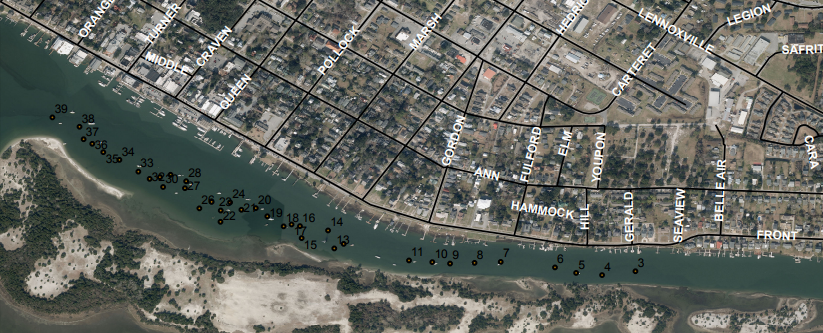
Editor’s Note: The Town of Beaufort Board of Commissioners rescheduled its regular work session for Oct. 30.
BEAUFORT – Town officials are again making an effort to manage illegal moorings and remove abandoned boats and marine debris from Taylor’s Creek, recurrent but unresolved issues for decades.
Supporter Spotlight
“In some cases, with the safety issues we have here, as well as water quality issues, we believe that there is an interest, certainly among residents here, to come up with a way to better manage the creek and make it safe,” Town Manager John Day said during a stakeholders meeting last week in the Boathouse at Front Street Village.

Stakeholders at the meeting included representatives from the Coast Guard, Army Corps of Engineers, North Carolina Division of Cultural Management, North Carolina Marine Patrol, North Carolina Wildlife Resources Commission, TowBoatUS, The Duke Marine Robotics and Remote Sensing Lab, North Carolina Coastal Reserve, The Department of Natural and Cultural Resources Underwater Archaeology Branch, area businesses, town staff and elected officials.
The discussion focused not only on the logistics of cleaning up the waterway, including who has jurisdiction to remove sunken vessels and illegal moorings, which is any mooring that does not have a current Coastal Area Management Act permit, but also on the possibility of developing a harbor management plan and sorting out details for a National Oceanic and Atmospheric Administration grant for marine debris removal. The grant proposal is due Nov. 1, and is to be presented to the Beaufort Board of Commissioners during its next work session set for 4 p.m. Monday, Oct. 30 in the train depot on Pollock Street.
Day explained as the meeting began that in 1981, the town received the authority from the North Carolina General Assembly to manage Taylor’s Creek, and there have been instances in the years since where the town has pursued management of Taylor’s Creek, but for various reasons did not to follow through.

Whitney Jenkins, coastal training program coordinator for the North Carolina Coastal Reserve & National Estuarine Research Reserve, served as meeting facilitator. She explained that the reserve routinely holds stakeholder meetings for organizational partners, and has been working with the town on a potential marine debris removal grant. The Rachel Carson Reserve, which is between the mouths of the Newport and North rivers and across Taylor’s Creek from downtown Beaufort, is part of the reserve.
Supporter Spotlight
To provide a better understanding of what lies beneath the relatively calm surface of Taylor’s Creek, Jenkins shared a map created by town staff showing the 39 moorings in the creek, illustrating the state of the waterway now. It was also explained that the commercial towing provider TowBoatUS and Duke University Marine Lab on nearby Pivers Island have been working together to create an underwater sonar map of Taylor’s Creek. That mapping process allowed them to identify a range of debris, including a handful of sunken vessels, more than a dozen abandoned moorings without markings and a few large sections of drainage pipe.
Representatives described the perimeters they could work within when it comes to removing abandoned boats in Taylor’s Creek as well as what each group was permitted to do as an organization to address marine debris and pollution.
Paula Gillikin, Rachel Carson Reserve site manager, explained that her involvement is mostly from a habitat standpoint, although there are safety concerns with some debris that washes ashore. She said that marine debris, such as dock sections, moorings, pieces of boats in all conditions, from sunken to abandoned, typically washes up on the marshes and beaches at the reserve.

“One of our primary concerns is habitat damage,” she added, and some of the boats that come ashore and damage the marsh cannot be dealt with in a timely and efficient manner, either because of the lack of funds or the inability to work with the vessel owner.
In the past, Gillikin said, the reserve has worked with stakeholders on regular marine debris removal, and has removed about 25,000 pounds.
“It’s a constant issue for us,” she said, adding that the reserve serves as an outdoor classroom, research lab and as a place for people to enjoy. The reserve also functions as a storm barrier, protecting the town, she added.
The stakeholders also discussed a possible harbor management plan for the town and weighed ideas, presented examples and noted the roles various agencies and the town would play if such a plan were to move forward.
Day said the immediate next step for the town would be to consider the National Oceanic and Atmospheric Administration marine debris removal grant proposal that Gillikin plans to present to the Beaufort Board of Commissioners later this month during its October work session. Day added that there’s also an interest at looking at other NOAA grants in the future for the Town Creek and Gallants Channel areas.

Day wrapped up the meeting by stressing that town commissioners have not issued any directives at this point but town staff will discuss with elected officials pursuing this issue and look at models for harbor management. Additionally, the manager said they will work to solidify the relationship with the various stakeholders to work together to achieve common goals.
“The intention is not to rush into this because there are other projects going on and we also want to include opportunities for public involvement and comment as we move through the process,” Day said. “We want to be very intentional about the way we move forward. We want to hear from all the stakeholders. If the town does take on and develop a harbor management plan, it’s going to require a number of resources, obviously a lot of time, a lot of effort and a lot of folks.”
Beaufort Planning Director Kyle Garner explained in an interview after the meeting that the town was working with the Rachel Carson Reserve staff to apply for the grant to clean up some of the marine debris adjacent to the reserve. “In doing so, we wanted to see who had control, who was responsible for jurisdictional water around Rachel Carson and, for that matter, Taylor’s Creek.”
Garner said that cleaning up Taylor’s Creek is important “Because some of the debris is having a negative environmental impact on the habitat located on the reserve, as well as creating safety concerns for navigation in Taylor’s Creek.”
But the first step is to work on the NOAA marine debris removal grant, he added.
Once the town is able to move forward with cleaning Taylor’s Creek, officials and staff will begin looking into the possibility of a harbor management plan.







